Vibrational Spectroscopic Discrimination of Herbal Medicines: Polygala senega, Polygala tenuifolia, and Glinus oppositifolius
Special Issues
The noninvasive discrimination of powdered root material belonging to the Polygala genus and an adulterant is presented. The quality of the approach is assessed for attenuated total reflectance mid-infrared spectroscopy and diffuse reflectance near-infrared spectroscopy. Due to the pharmaceutical importance of Polygala related plant material, conclusions are drawn towards a laboratory independent discrimination of the samples.
The noninvasive discrimination of powdered root material belonging to the Polygala genus and an adulterant is presented. The quality of the approach is assessed for attenuated total reflectance mid-infrared spectroscopy and diffuse reflectance near-infrared spectroscopy. Because of the pharmaceutical importance of Polygala-related plant material, conclusions are drawn toward a laboratory-independent discrimination of the samples.
Analytical methods using infrared (IR) spectroscopy have become indispensable tools in the field of natural product analysis, rapidly delivering results of high accuracy and robustness (1–6).
The Polygalaceae family is known to contain pharmaceutically important plants and the Polygala genus is especially of medicinal importance because many Polygala species are used in folk medicine (7). Two important medicinal plants of the Polygala genus are Polygala tenuifolia and Polygala senega.
The root of Polygala tenuifolia is a well-known traditional Chinese medicine herb that is used as an expectorant, a tranquilizer, and an antipsychotic agent (8), and for the treatment of neurological disorders such as dementia, amnesia, and neurasthenia (9). Polygala tenuifolia roots contain triterpenic saponins, and the dominating compounds are tenuifolin and triterpene saponins with polygalacic acid as sapogenin. Furthermore, xanthone derivatives and oligosaccharides can be isolated (8).
Polygala senega roots show expectorant and antitussive effects and are used to treat chronic bronchitis, cough, and tracheitis (10,11). Moreover an immunopotentiation activity was proven (12). The root contains up to 12% triterpenic saponins with presenegin as a sapogenin. Further compounds are lipids, xanthone derivatives, and oligosaccharides (11).
On the European market various Polygala adulterants are known. One of these adulterants is Glinus oppositifolius (family: Molluginaceae), also known as Indian senega root (13), which is applied in Indian medicine for the treatment of skin diseases because of its antiseptic and antidermatitic properties (14).
The aim of this study is to establish a simple and rapid authentication method of Polygalae radix samples using commercially available mid-infrared (MIR) and near-infrared (NIR) benchtop spectrometers alongside a topical laboratory independent handheld NIR device.
Methods
The discrimination models were set up with 38 reference samples: 24 Polygala tenuifolia, 12 Polygala senega, and 2 Glinus oppositifolius root samples were subjected to MIR and NIR analysis. For the MIR measurements at a resolution of 4 cm-1 (1 cm-1 data point interval), a Spectrum 100 spectrometer (Perkin Elmer), equipped with an universal attenuated total reflectance (uATR) sampling accessory, was operated between 3000 and 650 cm-1, accumulating 16 scans for each spectrum. NIR analysis was performed with a NIRFlex N500 spectrometer (Büchi) operated at a resolution of 8 cm-1 (4 cm-1 data point interval), accumulating 64 scans for the spectral region between 10,000 and 4000 cm-1. The laboratory-independent measurements were obtained using a MicroPhazir GP 4.0 analyzer (Thermo Scientific) that was operated between 6267 and 4173 cm-1 at a resolution of 21 cm-1. For each spectrum, 10 scans were accumulated. The data pretreatment and the qualitative cluster analysis were performed with Unscrambler 10.3 software (Camo Software AS) using principal component analysis (PCA) with the nonlinear iterative partial least squares algorithm. Every sample was measured in triplicate, and during the NIR measurements the sample compartment was rotated by 120° each time to average over the coarse grain of the ground samples. Before the multivariate analysis, an average spectrum was calculated for each set of replicates.
Besides full cross validation, the discrimination models were validated with two double-blind samples. After the spectroscopic analysis, the two double-blind samples were identified as Polygala senega root material via thin-layer chromatography (TLC) (15).
Results and Discussion
Benchtop NIR
For data pretreatment, full multiplicative scatter correction and a second derivative with nine smoothing points was used. The spectral region >6150 cm-1 was excluded from multivariate analysis because of the absence of significant absorptions. The interspectral variance is optimally described with five latent variables of which the first, third, and fifth variables were found to correlate with the investigated problem. Figure 1 shows the three-dimensional (3D) score plot, indicating appropriate clustering of the samples. The two double-blind samples were correctly ascribed to the Polygala senega cluster. Apparently, the different grain size of the samples is sufficiently well accounted for by rotating the sample cuvette and multiplicative scatter correction.
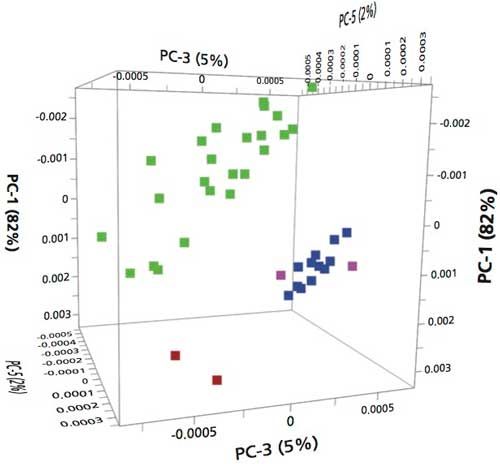
Figure 1: PCA score plot obtained with the benchtop NIR spectrometer. Green: Polygala tenuifolia, blue: Polygala senega, red: Glinus oppositifolius, pink: double-blind samples.
Benchtop MIR
Since the samples were pressed firmly onto the ATR sampling accessory, the influence of the grain size can be considered to be of subordinate importance in this approach. Hence, only a second derivative with 21 smoothing points was used for the selected wavenumber regions 3000–2666 cm-1 and 1864–650 cm-1. The region between 2665 and 1865 cm-1 was excluded because of the absence of absorption bands and the fact that the spectrometer’s deuterated triglycinesulfate detector exhibited an impaired signal-to-noise ratio in this region. Figure 2 shows that the MIR-derived score plot has an inferior quality, especially considering that one outlier has been excluded from the sample group. Whereas the two double-blind samples were correctly assigned to the Polygala senega cluster, the Polygala tenuifolia samples are distributed broadly over the score plot. Because the NIR-derived score plot (Figure 1) also exhibited a wide distribution of the Polygala tenuifolia samples, the grain size may be ruled out from having a significant influence on the qualitative cluster analysis. Since the ATR technique inherently defines the penetration depth of the incident light, an impaired performance of this MIR-based approach seems plausible, especially considering that NIR light per se allows for a larger sample thickness because of the higher energy.
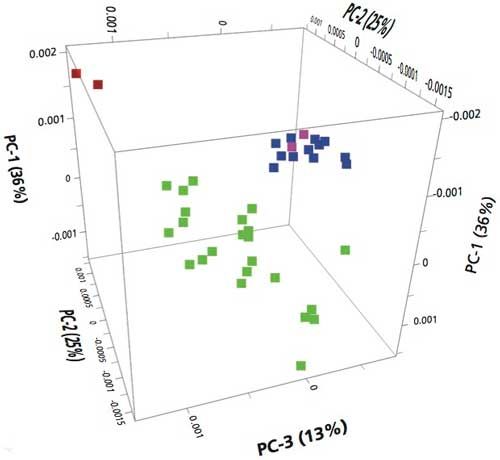
Figure 2: PCA score plot obtained with the benchtop MIR spectrometer. Green: Polygala tenuifolia, blue: Polygala senega, red: Glinus oppositifolius, pink: double-blind samples.
Mobile NIR
As a consequence of the promising performance of the benchtop NIR spectrometer, a commercially available mobile device was used to investigate the in-field applicability of the approach. The principal component analysis in Figure 3 is based on spectra that have been subjected to multiplicative scatter correction and a second derivative with five smoothing points. Considering the lower resolution and the limited spectral region, the most important spectral features necessary for a successful discrimination still seem to be captured with success. The absorption features responsible for the discrimination are summarized in Table I and have been identified from the loadings plots that were obtained during PCA.
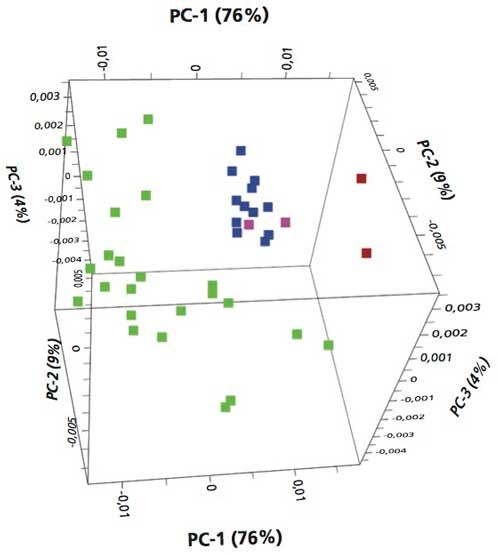
Figure 3: PCA score plot obtained for the mobile NIR spectrometer. Green: Polygala tenuifolia, blue: Polygala senega, red: Glinus oppositifolius, pink: double-blind samples.
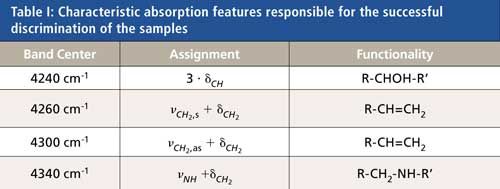
Since the distribution of the Polygala tenuifolia samples is much more evident as observed for the benchtop NIR score plot, more samples would be required until a definitive conclusion can be drawn toward applicability of the mobile appliance. As a tentative indicator of the discrimination’s plausibility, however, the two double-blind samples could still be ascribed to the appropriate group successfully.
Concluding Remarks
From the data presented, it was concluded that a noninvasive discrimination of the two important Polygala species and an adulterant is plausible when using spectroscopic techniques. Even though the data obtained with the mobile NIR spectrometer are less precise, the recent development of microchip-based infrared sensors (16) can be considered an important step toward reliable laboratory independent identification of pharmaceutically relevant herbs. Moreover, such mobile devices are currently being applied in industrially relevant qualitative (2) and quantitative (1,17) contexts, emphasizing the demand for in-field spectroscopic techniques.
Acknowledgments
Special thanks are given to Leopold-Franzens University Innsbruck, Austria (Hypo Bank Forschungsförderung), project “Quantum cascade lasers in mid infrared spectroscopy - a novel approach for infrared characterization of highly absorbing liquid and solids” (2012), the Ministry for Science and Research and the Ministry for Health, Family and Youth (Vienna, Austria) (Novel analytical tools for quality control of immunomodulatory, anti-inflammatory, and neuroprotective agents in traditional Chinese medicine).
References
- M. Alcalà, M. Blanco, D. Moyano, N. Broad, N.A. O’Brien, D. Friedrich, F. Pfeifer, and H. Siesler, J. Near Infrar. Spectrosc. 21, 445–457 (2013).
- N.A. O’Brien, C. Hulse, F. Pfeifer, and H. Siesler, J. Near Infrar. Spectrosc.21, 299–305 (2013).
- M. Popp, G. Bonn, C. Huck, and W. Guggenbichler, Method for Classifying Wine and Coffee, 2003. WO Patent App. PCT/EP2002/004,988.
- M. Schmutzler and C.W. Huck, Vibr. Spectrosc. 72, 97–104 (2014).
- L.M. Reid, C.P. O’Donnell, and G. Downey, Trends Food Sci. & Techn.17, 344–353 (2006).
- B.M. Nicola, K. Beullens, E. Bobelyn, A. Peirs, W. Saeys, K.I. Theron, and J. Lammertyn, Postharv. Biol. and Technol.46, 99–118 (2007).
- L.C. Klein Júnior, S. Faloni de Andrade, and V.C. Filho, Chem. and Biodiv.9, 181–209 (2012).
- W. Tang and G. Eisenbrand, Pharmacol., Toxicol. 2, 919–922 (2011).
- H.-M. Chang, P.P. But, S.-C. Yao, L. Wang, and S. Yeung, Pharmacology and Applications of Chinese Materia Medica1, 1029–1032 (2000).
- E. Steinegger, R. Hänsel, in Pharmakognosie (Springer, 1999), pp. 212–213.
- M. Wichtl, J.A. Brinckmann, and M.P. Lindenmaier, Schweizer Zeitschri. f. Ganzheitsmed.4, 464–466 (2002).
- A. Estrada, G.S. Katselis, B. Laarveld, and B. Barl, Comp. Immunol., Microbiol.and Infect. Dis.23, 27–43 (2000).
- R. Hegnauer, in Chemotaxonomie der Panzen (Springer, 1964), pp. 30–35.
- B.N. Sastri, in The Wealth of India, Raw Materials (Council of scientific and industrial research, volume 6, New Delhi, India,1962), pp. 396–397.
- S. Kuderer, “Wissenschaftliche Erstellung der Monographie Polygalae extractum uidum für das österreichische Arzneibuch,” diploma thesis, University of Vienna (2014).
- N.A. O’Brien, C.A. Hulse, D.M. Friedrich, F.J.V. Milligen, M.K. von Gunten, F. Pfeifer, and H.W. Siesler, “Miniature Near-Infrared (NIR) Spectrometer Engine For Handheld Applications” presented at SPIE DSS, Baltimore, Maryland, 2012.
- O.M. Lutz, G.K. Bonn, B.M. Rode, and C.W. Huck, Anal. Chim. Acta826, 61–68 (2014).
Cornelia K. Pezzei, Oliver M.D. Lutz, Verena A. Huck-Pezzei, and Christian W. Huck are with Institute of Analytical Chemistry and Radiochemistry at the University of Innsbruck, in Innsbruck, Austria. Sarah Kuderer and Brigitte Kopp are with the Department of Pharmacognosy at the University of Vienna in Vienna, Austria. Direct correspondence to: christian.w.huck@uibk.ac.at
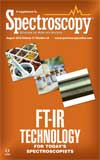
AI Shakes Up Spectroscopy as New Tools Reveal the Secret Life of Molecules
April 14th 2025A leading-edge review led by researchers at Oak Ridge National Laboratory and MIT explores how artificial intelligence is revolutionizing the study of molecular vibrations and phonon dynamics. From infrared and Raman spectroscopy to neutron and X-ray scattering, AI is transforming how scientists interpret vibrational spectra and predict material behaviors.
Real-Time Battery Health Tracking Using Fiber-Optic Sensors
April 9th 2025A new study by researchers from Palo Alto Research Center (PARC, a Xerox Company) and LG Chem Power presents a novel method for real-time battery monitoring using embedded fiber-optic sensors. This approach enhances state-of-charge (SOC) and state-of-health (SOH) estimations, potentially improving the efficiency and lifespan of lithium-ion batteries in electric vehicles (xEVs).
New Study Provides Insights into Chiral Smectic Phases
March 31st 2025Researchers from the Institute of Nuclear Physics Polish Academy of Sciences have unveiled new insights into the molecular arrangement of the 7HH6 compound’s smectic phases using X-ray diffraction (XRD) and infrared (IR) spectroscopy.